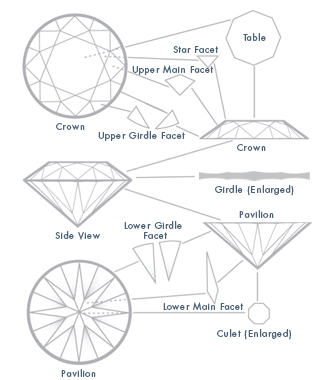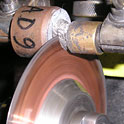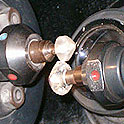MANUFACTURING THE DIAMOND
Cut is the only diamond characteristic under human control, and considered by many to be the most important. A good cut can offset a lower color or clarity; however, even a D-color, Internally Flawless stone will not look its best if the cut or "make" is poor. A poor cut actually reduces the brilliance, sparkle and scintillations of a diamond.
The decision to cut a diamond in a particular shape is dictated by the natural shape of the rough stone. Some stones are naturally oblong and are destined to become marquises, ovals or pear shapes. Some rough diamonds occur in near perfect crystal shapes and these will more than likely be cut as princess cuts or some other square cut.

Diamond cutting is a lengthy and difficult task, requiring a great deal of knowledge and experience. Understanding this process may give you some appreciation of the various aspects of creating your gorgeous Diamond Ideals diamond.
CUTTING PROCESS
Diamond cutting has been a work in progress since the first diamonds were cut in the mid 1300s. Cuts have evolved from the first and most simplistic point cut - a basic four-sided cut that resembles the outline of rough octahedral crystals - to the table cut, single cut, old mine cut, old European cut and finally the modern brilliant cut. When the single cut was developed in the early 1600s it became apparent that more facets meant more brilliance and it was the single cut that laid the foundation for the modern brilliant cut that is so popular today.
The modern round brilliant cut diamond consists of a round outline, symmetrical triangular and kite-shaped facets, a table, and a small culet or no culet at all.

Verena Pagel-Theisen, Diamond Grading ABC: Handbook for Diamond Grading, 1980, p.154
Incredible amounts of patience, skill and consideration are required to transform the world's hardest material into a beautiful and valuable polished gem. A cutter must carefully consider the size, shape, cleavage planes and even inclusions when preparing to fashion a rough diamond. The ultimate goal is to end up with the best cut and the most carat weight possible at the lowest production cost. This results in some difficult decisions.
THE FOUR BASIC STEPS FOR DIAMOND CUTTING
 Planning
PlanningPlanning is a crucial step in diamond manufacturing because during this stage the size and relative value of the cut stones that the rough will produce are determined. A person called a planner decides where to mark the diamond rough for fashioning into the most profitable polished gem(s). The planner must consider the size, clarity and crystal direction when deciding where to mark the diamond rough. Incorrectly marking a diamond by a fraction of a millimeter can make a difference of thousands of dollars in some cases. In addition, if one attempts to cleave a diamond in the wrong position, the diamond could shatter and become worthless.
 Cleaving or sawing
Cleaving or sawingOnce the planner decides where the diamond should be cut, the diamond is either manually cleaved or sawed. Sawing can be done with a diamond-coated rotary saw or a laser.
 Bruting
BrutingBruting forms the basic face-up outline of a round diamond to prepare it for faceting. During the bruting phase the diamond being bruted is spun on a rotating lathe while another diamond is forced against it, gradually forming the rounded outline. Essentially, one diamond is used to shape the other.
 Polishing
PolishingPolishing is the final stage of the cutting process, giving the diamond its finished proportions. The first and perhaps most crucial polishing stage is blocking. This step lays the foundation for the potential of the diamond's performance because it establishes the diamond's basic symmetry. During the blocking stage, the first 17 or 18 facets are made, creating a single cut. For some very small diamonds, the process stops here. Larger diamonds go on to the brillianteering stage. In this process a specialist called a brillianteer, polishes the final facets. It is this stage that will determine how much brilliance and fire a diamond displays. Minor inconsistencies in symmetry and proportions can make the difference between a gorgeous diamond and a dull, lifeless stone. The Hearts and Arrows in our beautiful diamonds are the result of a skilled and mastered brillianteer.
Were your questions answered? Click here to contact us today.






